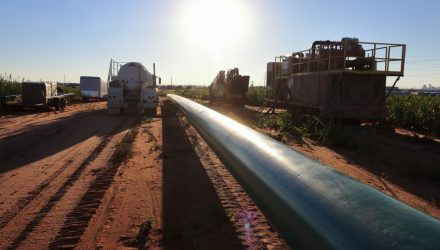Compelling yields and real assets exposure are two primary reasons why investors allocate to midstream.
While midstream has significantly outperformed broader markets, the space has not become expensive nor is considered overbought. Valuations are still discounted, making now an ideal time to consider adding or reinstating a position in a fund offering exposure to the energy infrastructure sector.
“When we think about the midstream or energy infrastructure space, we’re really talking about those companies that perform the shipping and handling function of the energy value chain. These are companies that are providing services for a fee,” Stacey Morris, head of energy research at VettaFi, said on December 6 during Midstream/MLPs: Can the Tailwinds Continue into 2023?
Other segments of the energy value chain include upstream, which comprises oil and gas producers and oilfield service companies, and downstream, which are the businesses that operate closer to the end user, including refineries, petrochemical businesses, and gas stations. Midstream is the segment that connects the supply from upstream with the demand that’s downstream.
“The bread and butter of the midstream space has generally been pipelines, but these companies are also involved in storing hydrocarbons – storing even things like renewable fuels and renewable fuels feedstocks,” Morris said. “These companies are also involved in processing natural gas and natural gas liquids (NGLs).”
The midstream segment primarily makes money through fee-based contracts, which range in length from one to 25 years (e.g. pipelines tend to have longer contracts, whereas storage facilities tend to have shorter contracts). This makes midstream less sensitive to and dependent upon commodity prices.
“We don’t necessarily need to see WTI oil go to $100 or $120 for this space to work because we’ve seen plenty examples this year of crude prices deteriorating but energy stocks and midstream and MLPs still doing very well,” Morris said.
With this set fee schedule, midstream companies are also able to provide guidance for the year ahead, something that isn’t possible in other segments of the energy value chain that are more sensitive to commodity prices. Midstream is in the position to have better visibility to what free cash flow will look like, something that won’t change much based on oil prices, Morris added.
Another benefit of the fee-based business model is that contracts typically have annual adjustments for inflation.
“That makes sense when you’re talking about contracts that are 10 years or more in length,” Morris said. “A number of liquids pipelines also follow the FERC Index. So the FERC sets an index every five years — currently, it’s based on the Producer Price Index for finished goods minus .21%. So pipelines that follow this index are able to increase their rates every July 1 based on this formula. July 1 of this year, the increase was about 8.7%. Given that we saw pretty high inflation this year, it’ll probably mean that we’ll see a pretty nice adjustment or next year as well on July 1, 2023.”
This has led midstream to generally outperform broader markets in high inflation years since 2000, with the one exception being in 2008 when midstream modestly underperformed.
While oil has long been a focus for midstream, future growth opportunities favor natural gas and NGLs. These opportunities include new-build pipelines and expansions.
“Williams, for example, is developing the Louisiana Energy Gateway to gather Haynesville gas and take it to the Gulf Coast,” Morris said. “Then there are several examples of new pipeline expansions or new build pipelines coming out of the Permian to move natural gas to the coast. So, whether it’s Kinder Morgan, MPLX, EPD, a number of household midstream names are working on solving the problem of getting extra natural gas production out of the Permian into in markets.”
60.2% of the Alerian MLP Infrastructure Index (AMZI) and 70.5% of the Alerian Midstream Energy Select Index (AMEI) by weighting is focused on transporting and processing natural gas and NGLs. Investors can gain exposure to the AMZI and AMEI indexes with the Alerian MLP ETF (AMLP) and the Alerian Energy Infrastructure ETF (ENFR), respectively.
The Inflation Reduction Act also offers a raft of opportunities for the midstream sector.
“When people think about the Inflation Reduction Act, I don’t think midstream is probably at the top of mind. You probably think about solar and wind,” Morris said. “But there are benefits in the Act for midstream. Midstream has been focused on things around renewable fuels, carbon capture, hydrogen, and they’ve announced a lot of significant partnerships in these different areas.”
Morris cited examples including Enterprise Products Partners partnering with Chevron on carbon capture, as well as NuStar and Kinder Morgan working with Neste on renewable fuels.
How Investors Can Access the Midstream Space
SS&C ALPS has two strategies that offer investors exposure to the energy infrastructure space: the Alerian MLP ETF (AMLP) which offers exposure to MLPs that operate in the energy infrastructure space, and the Alerian Energy Infrastructure ETF (ENFR), which provides exposure to the energy infrastructure space, but broadens the universe to include both C-Corps and MLPs.
AMLP is primarily used for income, offering the potential for tax-deferred income. Between 80–85% of AMLP’s distributions historically have been considered a tax-deferred return of capital.
ENFR is RIC-compliant, meaning it caps MLP exposure at 25%. The other 75% of the portfolio is U.S. and Canadian energy infrastructure corporations. ENFR and other RIC-compliant ETFs tend to be more focused on total return as opposed to income.
The underlying indexes of both funds have not seen a dividend cut since July 2021, with a bias toward growth.
Notably, neither fund comes with the hassle of a K-1.
Financial advisors interested in learning more about energy infrastructure can watch the webcast here on demand.
vettafi.com is owned by VettaFi, which also owns the index provider for ENFR and AMLP. VettaFi is not the sponsor of ENFR and AMLP, but VettaFi’s affiliate receives an index licensing fee from the ETF sponsor.

